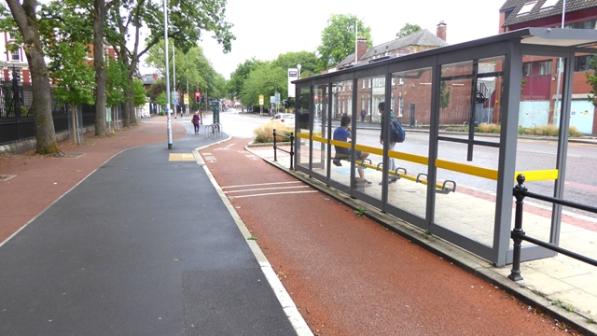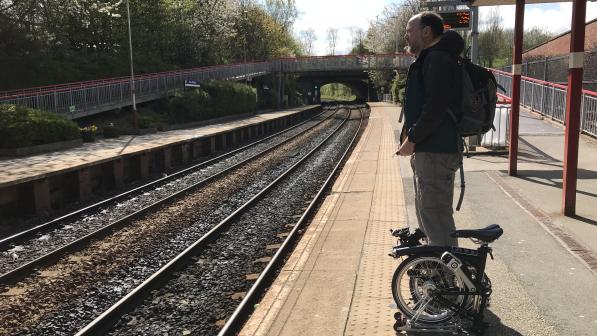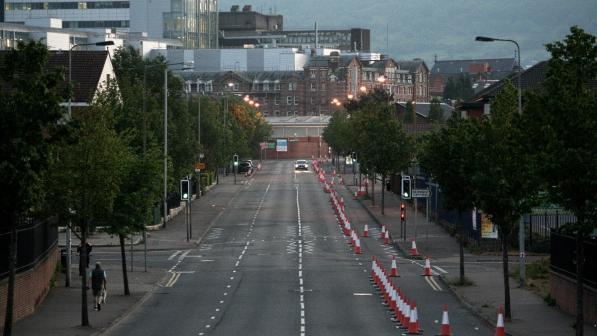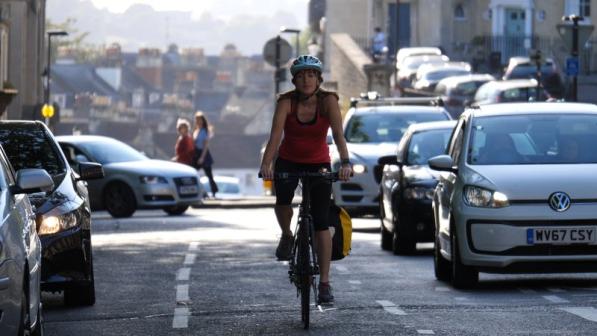More cycling and fewer cars: the funding must follow the vision

Earlier this year, the transport secretary, Grant Shapps, initiated the process of drafting a Transport Decarbonisation Plan (TDP), due out later this year, with a document called Decarbonising transport: setting the challenge. You may recall that his opening 'foreword' blew my mind, and many other sustainable transport campaigners were similarly 'gobsmacked'. Shapps sat out a vision of a net-zero future, in which:
"Public transport and active travel will be the natural first choice for our daily activities. We will use our cars less..."
I have previously written about Cycling UK's response to the TDP consultation (see our full response or a summary of it). In short, we argued that the TDP should do the following:
- It should set targets to halt and reverse the growth of road traffic. Those reductions need to be steep and rapid enough to support the government’s wider ‘net zero’ target. Research for Friends of the Earth suggests that this will require reductions of between 20% and 60% by 2030, which is massive. However, given that Grant Shapps has agreed that "We should use our cars less", the government must surely now say when they expect to halt road traffic growth, then how quickly it will be reversed, in accordance with its wider 'net zero' target.
- Having determined the level of road traffic reduction needed to meet its 'net zero' commitment, the government should then estimate the corresponding increases required in walking, cycling, public transport and other sustainable options, including not travelling at all (e.g. thanks to broadband investment).
- Finally, it should estimate the funding requirements to meet the above targets.
Our response to the Comprehensive Spending Review (available to download at the bottom of this article) effectively sets out our estimate of the funding required to meet the government's existing targets to increase cycling and walking, as set out in its first Cycling and Walking Investment Strategy (CWIS1). By committing additional investment for cycling and walking, the Treasury can make it much easier for the Department for Transport (DfT) to fulfil the prime minister's 'vision' for cycling and walking set out in the government's excellent 'Gear Change' document, when it meets its legal requirement to issue a second Cycling and Walking Investment Strategy (CWIS2) sometime in the spring.
Backing the government's 'vision' with funding
'Gear Change', published in July, demonstrates a genuinely impressive level of political commitment to boost cycling and walking. Prefaced with a foreword by the prime minister, it set out plans for:
- “Better streets for cycling and people”: including “first hundreds, then thousands of miles of safe, continuous, direct routes for cycling in towns and cities”, as well as “cycle, bus and walking corridors”, “low-traffic neighbourhoods”, “school streets” and “Mini-Hollands”. It also insists that all new transport projects should incorporate DfT’s new Cycle Infrastructure Design standards, issued on the same day as ‘Gear Change’.
- “Putting cycling and walking at the heart of transport, place-making and health policy”: including “significantly increase[d] spending” with “a long-term cycling and walking programme and budget, like the roads programme and budget”. It also proposes: improved provision for cycling along and across the strategic and major A road networks; better integration of cycling with both rail and bus travel; promotion of cycling for deliveries and reductions in unnecessary freight traffic; increased cycle parking; incorporating cycling and walking into new housing and business developments; and new tools for auditing roads and for assessing the value of transport projects.
- “Empowering and encouraging local authorities”: providing them with “significantly increased funding” and support for capacity-building; both of which are to be delivered though Active Travel England, which is to be “a new funding body and inspectorate to enforce the [cycling infrastructure design] standards and time limits" [for delivering schemes]. Active Travel England will report on local authorities’ performance (with these reports being used to influence their wider transport funding allocations), and will be a statutory consultee on larger new developments.
- “Enabl[ing] people to cycle and protect[ing] them when they cycle”: including increased cycle training provision for adults as well as children, a ‘social prescribing’ scheme in which GPs are incentivised to ‘prescribe’ cycling (alongside improved cycling infrastructure provision) in places with poor health; support for the uptake of electrically assisted pedal cycles (or ‘e-bikes’); action to reduce cycle theft; new road traffic offences; and the review of the Highway Code which is now underway.
This is all admirable stuff, and Cycling UK's response to the CSR reflects these proposals. On top of these, we have called for investment in bike share schemes (such as London's Santander Cycles or 'Boris Bikes'). We have also urged the government to place greater emphasis on boosting cycle use among groups who are under-represented in cycling: children, older people, people with health conditions or disabilities, people from ethnic minorities and/or from disadvantaged regions and communities. One specific proposal we have made is to provide vouchers to support children and young people who are recieving free school meals. This would really help with the government's 'levelling up' agenda.
Rebalancing transport funding
Crucially though, we have argued that increases in spending on cycling and walking should not require an increase in overall transport funding. On the contrary, if we are to "use our cars less", one immediately starts to wonder why the government still plans to spend £27bn on England's motorways and trunk roads, with about £14bn of this being for new or widened roads and junctions. These schemes would have hugely damaging climate impacts: our allies at Transport Action Network have launched a crowd-funded legal action to challenge the government's alleged failure to take account of these impacts. They would also exacerbate urban congestion and pollution, and would provide far worse value for money than investment in cycling and walking.
The government could also use fuel duty and other charging mechanisms both to reduce road traffic demand - thereby helping to meet its 'net zero' target - and to raise funds for investment in healthy and sustainable alternatives (thereby killing two birds with one stone). We cite evidence that, as a result of fuel duty being frozen between 2011 and 2018, pump prices were estimated to be 13% lower in 2018 than they otherwise would have been, and that road traffic levels were therefore 4% higher. This resulted in an extra 4.5m tonnes of CO2 emissions (as well as increased emissions of nitrogen oxides and particulates), while public transport use was between 1.3% and 3.9% lower. It also cost the Treasury around £46bn in lost fuel duty revenue over that period.
Hiding the evidence of how much is needed
They key question though is how much should the government be investing in cycling and walking over the next 5 years (2020/1 to 2024/5)? So let's start by saying that it's a lot more than £2bn!
True, this is a welcome six-fold increase in 'ringfenced' funding for cycling and walking, compared with the meagre £314m of 'ringfenced' funding in CWIS1 three years ago (covering the period 2016/7 to 2020/1 - n.b. there is a one-year overlap between the two 5-year time-periods). However, once you include all the extra non-ringfenced funding that DfT's resourceful cycling and walking team managed to secure from sources like the Transforming Cities Fund, total investment over the past 5 years came to £2.4bn. So, if all end up for the next five years is the £2bn that has already been announced (which seems to be what the Treasury is thinking), that would actually be a reduction in funding. It would completely undermine the commitments in 'Gear Change' to "significantly increase spending" on cycling and walking, providing "a long-term cycling and walking programme and budget, like the roads programme and budget", and to "end the stop-go nature of previous cycling and walking funding allowing local authorities and other to plan in a long-term way".
However, we are hampered in our ability to answer the "how much is needed?" question, because the government has refused to publish the 'Cycling Insights' research report which it commissioned from consultants Transport for Quality of Life, to assess the funding needed to meet its targets (as set out in CWIS1) to double cycling trips and to increase walking by 2025. Despite repeated promises to release it, the government has recently rejected a Freedom of Information request from Cycling UK to publish this research, arguing that it is still being used to formulate policy.
For one thing, this is preventing stakeholders such as ourselves from providing informed responses to the government's own CSR consultation. However it also means the Treasury cannot legitimately have decided that there will be no further funding for cycling and walking in the CSR, having refused our FoI request for the 'Cycling Insights' report on the grounds that it is still being used to inform policy-making!
So how much is needed? About £8bn
We understand however that the report suggests that £2bn is only about one quarter to one third of what is needed to meet the government's cycling and walking targets. We also know (from the parts of the research project that have been published) that the researchers considered various 'scenarios', i.e. different ways in which those targets might be met. Some scenarios involve reaching the target by investing in places and demographic groups which already have relatively high levels of cycling and walking. This is a 'cheap' way to meet the targets, but yields far lower benefits, as the people who would make these additional cycling and walking trips are already relatively affluent, healthy and with good transport links to the places they want to get to. A more expensive, but markedly more beneficial approach is to spread a greater proportion of the funding to more disadvantaged areas - and indeed to rural areas, where cycling could potentially replace some longer trips (particularly if a reasonable amount of funding goes towards supporting sales of e-bikes).
In the absence of the government's research, we have therefore put forward two potential scenarios of our own:
- A £6bn scenario, which could be expected to meet the government’s targets, however its benefits are still concentrated in areas where levels of cycling and walking are already reasonably high, and among relatively healthy and affluent population groups. It is therefore relatively poor at ‘levelling up’ people's ability in different parts of the country to gain the health, environmental, well-being and economic benefits of walking and cycling.
- An £8bn scenario, which would meet the government’s targets in a way that also distributes the benefits of cycling and walking to more rural areas and to more areas of deprivation. It would therefore achieve significantly greater benefits for the health, wealth and well-being of disadvantaged areas, while achieving greater carbon reduction and other benefits by also boosting cycling in more rural areas.
However we continue to urge the government to release the 'Cycling Insights' report. This would allow for a much more open and better-informed debate about how much funding is needed, and how best to invest it.
We are faced with a climate crisis, an urban congestion and air pollution crisis, a road danger crisis and an inactivity-related health crisis. It is vital that the government allocates the funding needed to meet its cycling and walking targets, and to fulfil its vision for cycling and walking, as part of a clean and healthy 'net-zero' future. It should release its 'Cycling Insights' report, showing what funding is needed, and how best to spend it. Above all though, the Treasury must then act on it!




